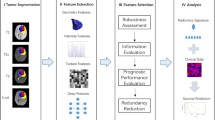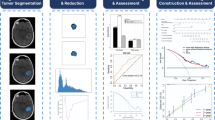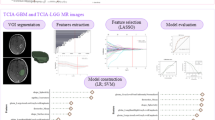Abstract
Lower-grade gliomas (LGG) can eventually progress to glioblastoma (GBM) and death. In the context of the transfer learning approach, we aimed to train and test an MRI-based radiomics model for predicting survival in GBM patients and validate it in LGG patients. From each patient’s 704 MRI-based radiomics features, we chose seventeen optimal radiomics signatures in the GBM training set (n = 71) and used these features in both the GBM testing set (n = 31) and LGG validation set (n = 107) for further analysis. Each patient’s risk score, calculated based on those optimal radiomics signatures, was chosen to represent the radiomics model. We compared the radiomics model with clinical, gene status models, and combined model integrating radiomics, clinical, and gene status in predicting survival. The average iAUCs of combined models in training, testing, and validation sets were respectively 0.804, 0.878, and 0.802, and those of radiomics models were 0.798, 0.867, and 0.717. The average iAUCs of gene status and clinical models ranged from 0.522 to 0.735 in all three sets. The radiomics model trained in GBM patients can effectively predict the overall survival of GBM and LGG patients, and the combined model improved this ability.
Graphical Abstract












Similar content being viewed by others
References
Ostrom QT et al (2018) Epidemiology of intracranial gliomas. Prog Neurol Surg 30:1–11
Ohgaki H, Kleihues P (2005) Epidemiology and etiology of gliomas. Acta Neuropathol 109(1):93–108
Ostrom QT et al (2014) The epidemiology of glioma in adults: a “state of the science” review. Neuro Oncol 16(7):896–913
Komori T (2017) The 2016 WHO classification of tumours of the central nervous system: the major points of revision. Neurol Med Chir (Tokyo) 57(7):301–311
Delfanti RL et al (2017) Imaging correlates for the 2016 update on WHO classification of grade II/III gliomas: implications for IDH, 1p/19q and ATRX status. J Neurooncol 135(3):601–609
Louis DN et al (2021) The 2021 WHO classification of tumors of the central nervous system: a summary. Neuro Oncol 23(8):1231–1251
Sanghani P et al (2018) Overall survival prediction in glioblastoma multiforme patients from volumetric, shape and texture features using machine learning. Surg Oncol 27(4):709–714
Stupp R et al (2014) High-grade glioma: ESMO Clinical Practice Guidelines for diagnosis, treatment and follow-up. Ann Oncol 25:iii93–iii101
Stummer W et al (2006) Fluorescence-guided surgery with 5-aminolevulinic acid for resection of malignant glioma: a randomised controlled multicentre phase III trial. Lancet Oncol 7(5):392–401
Thakkar JP et al (2014) Epidemiologic and molecular prognostic review of glioblastoma. Cancer Epidemiol Biomarkers Prev 23(10):1985–1996
Network CGAR (2015) Comprehensive, integrative genomic analysis of diffuse lower-grade gliomas. N Engl J Med 372(26):2481–2498
Gorlia T et al (2013) New validated prognostic models and prognostic calculators in patients with low-grade gliomas diagnosed by central pathology review: a pooled analysis of EORTC/RTOG/NCCTG phase III clinical trials. Neuro Oncol 15(11):1568–1579
Li G et al (2022) An MRI radiomics approach to predict survival and tumour-infiltrating macrophages in gliomas. Brain 145(3):1151–1161
Yan J et al (2021) Quantitative MRI-based radiomics for noninvasively predicting molecular subtypes and survival in glioma patients. NPJ Precis Oncol 5(1):1–9
Chato L, Latifi S (2021) Machine learning and radiomic features to predict overall survival time for glioblastoma patients. J Pers Med 11(12):1336
Lu Y et al (2020) Machine learning-based radiomic, clinical and semantic feature analysis for predicting overall survival and MGMT promoter methylation status in patients with glioblastoma. Magn Reson Imaging 74:161–170
Bae S et al (2018) Radiomic MRI phenotyping of glioblastoma: improving survival prediction. Radiology 289(3):797–806
Choi YS et al (2020) Machine learning and radiomic phenotyping of lower grade gliomas: improving survival prediction. Eur Radiol 30(7):3834–3842
Zhang H et al (2016) Radiomics for survival analysis and prediction in glioblastoma (GBM)—a preliminary study. Int J Radiat Oncol Biol Phys 96(2):E106–E107
Choi Y et al (2021) Radiomics may increase the prognostic value for survival in glioblastoma patients when combined with conventional clinical and genetic prognostic models. Eur Radiol 31(4):2084–2093
Aerts HJ et al (2014) Decoding tumour phenotype by noninvasive imaging using a quantitative radiomics approach. Nat Commun 5:4006
Oberheim Bush NA, Chang S (2016) Treatment strategies for low-grade glioma in adults. J Oncol Pract 12(12):1235–1241
Claus EB et al (2015) Survival and low-grade glioma: the emergence of genetic information. Neurosurg Focus 38(1):E6
Bakas S et al (2017) Advancing the cancer genome atlas glioma MRI collections with expert segmentation labels and radiomic features. Sci Data 4(1):1–13
Rathore S et al (2017) Brain cancer imaging phenomics toolkit (brain-CaPTk): an interactive platform for quantitative analysis of glioblastoma. In: Brainlesion: glioma, multiple sclerosis, stroke and traumatic brain injuries: Third International Workshop, BrainLes 2017, held in Conjunction with MICCAI 2017, Quebec City, QC, Canada. Revised selected papers 3, pp 133–145
Bakas S et al (2020) Overall survival prediction in glioblastoma patients using structural magnetic resonance imaging (MRI): advanced radiomic features may compensate for lack of advanced MRI modalities. J Med Imaging (Bellingham) 7(3):031505
Baid U et al (2020) Overall survival prediction in glioblastoma with radiomic features using machine learning. Front Comput Neurosci 14:61
Priya S et al (2021) Survival prediction in glioblastoma on post-contrast magnetic resonance imaging using filtration based first-order texture analysis: comparison of multiple machine learning models. Neuroradiol J 34(4):355–362
Mao X et al (2018) A 15-long non-coding RNA signature to improve prognosis prediction of cervical squamous cell carcinoma. Gynecol Oncol 149(1):181–187
Sana J et al (2014) Risk score based on microRNA expression signature is independent prognostic classifier of glioblastoma patients. Carcinogenesis 35(12):2756–2762
Li C et al (2020) Identification of a four-gene panel predicting overall survival for lung adenocarcinoma. BMC Cancer 20(1):1198
Xue M et al (2019) Identification of prognostic signatures for predicting the overall survival of uveal melanoma patients. J Cancer 10(20):4921
Shang J et al (2017) Identification of lung adenocarcinoma specific dysregulated genes with diagnostic and prognostic value across 27 TCGA cancer types. Oncotarget 8(50):87292
Pak E et al (2021) Prediction of prognosis in glioblastoma using radiomics features of dynamic contrast-enhanced mri. Korean J Radiol 22(9):1514
Qian Z et al (2018) Radiogenomics of lower-grade gliomas: a radiomic signature as a biological surrogate for survival prediction. Aging (Albany NY) 10(10):2884
Ma C et al (2021) Quantitative integration of radiomic and genomic data improves survival prediction of low-grade glioma patients. Math Biosci Eng 18(1):727–744
Tian M et al (2018) Impact of gender on the survival of patients with glioblastoma. Biosci Rep 38(6):BSR20180752
Sun Y et al (2019) Characteristics and prognostic factors of age-stratified high-grade intracranial glioma patients: a population-based analysis. Bosn J Basic Med Sci 19(4):375
Han S et al (2020) IDH mutation in glioma: molecular mechanisms and potential therapeutic targets. Br J Cancer 122(11):1580–1589
Fuster-Garcia E et al (2021) MGMT methylation may benefit overall survival in patients with moderately vascularized glioblastomas. Eur Radiol 31(3):1738–1747
Han F et al (2016) PTEN gene mutations correlate to poor prognosis in glioma patients: a meta-analysis. Onco Targets Ther 9:3485
Tan Y et al (2019) Improving survival prediction of high-grade glioma via machine learning techniques based on MRI radiomic, genetic and clinical risk factors. Eur J Radiol 120:108609
Dar JA, Srivastava KK, Lone SA (2022) Fr-WCSO-DRN: fractional water cycle swarm optimizer-based deep residual network for pulmonary abnormality detection from respiratory sound signals. SN Comput Sci 3(5):378
Dar JA, Srivastava KK, Ahmed Lone S (2022) Design and development of hybrid optimization enabled deep learning model for COVID-19 detection with comparative analysis with DCNN, BIAT-GRU. XGBoost. Comput Biol Med 150:106123
Ponnupilla Omana S et al (2023) Henry gas bird swarm optimization algorithm-based deep learning for brain tumor classification using magnetic resonance imaging. Concurr Comput: Pract Exp 35(4):e7541
Kudulaiti N et al (2021) A nomogram for individualized prediction of overall survival in patients with newly diagnosed glioblastoma: a real-world retrospective cohort study. BMC Surg 21(1):1–11
Paul R et al (2016) Deep feature transfer learning in combination with traditional features predicts survival among patients with lung adenocarcinoma. Tomography 2(4):388–395
Vial A et al (2018) The role of deep learning and radiomic feature extraction in cancer-specific predictive modelling: a review. Transl Cancer Res 7(3):803–816
Dar JA, Srivastava KK, Lone SA (2022) Spectral features and optimal hierarchical attention networks for pulmonary abnormality detection from the respiratory sound signals. Biomed Signal Process Control 78:103905
Funding
This work was supported by the National Science and Technology Council, Taiwan (grant numbers MOST110-2221-E-038–001-MY2 and MOST111-2628-E-038–002-MY3).
Author information
Authors and Affiliations
Corresponding author
Ethics declarations
Conflict of interest
The authors declare no competing interests.
Additional information
Publisher's note
Springer Nature remains neutral with regard to jurisdictional claims in published maps and institutional affiliations.
Supplementary Information
Below is the link to the electronic supplementary material.
Rights and permissions
Springer Nature or its licensor (e.g. a society or other partner) holds exclusive rights to this article under a publishing agreement with the author(s) or other rightsholder(s); author self-archiving of the accepted manuscript version of this article is solely governed by the terms of such publishing agreement and applicable law.
About this article
Cite this article
Le, V.H., Minh, T.N.T., Kha, Q.H. et al. A transfer learning approach on MRI-based radiomics signature for overall survival prediction of low-grade and high-grade gliomas. Med Biol Eng Comput 61, 2699–2712 (2023). https://doi.org/10.1007/s11517-023-02875-2
Received:
Accepted:
Published:
Issue Date:
DOI: https://doi.org/10.1007/s11517-023-02875-2




